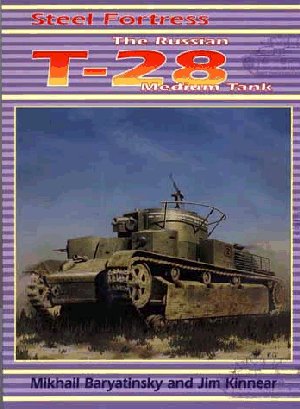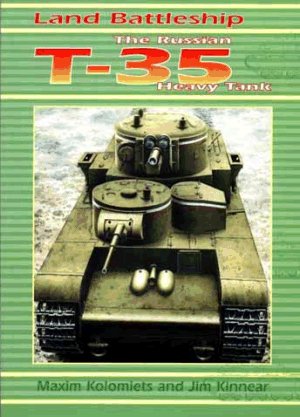

Steel Fortress T28 & Land Battleship T35 books
Peter Brown


Steel Fortress - The Russian T-28 Medium Tank by Mikhail Baryatinsky and Jim Kinnear Published by Barbarossa Books, Zhukov House, 14b Maldon Road, Tiptree, Essex CO5 0LL, England. email barbook@dircom.co.uk ISBN 0-9538777-0-1 128 pages, soft covers, price £14.00
While more material on Russian armour has become available in recent
years, the books and magazines it is published in are written in Russian, often published
in limited quantities and in some cases printed to standards which are not as good as many
in the West. These three drawbacks are all solved by this new venture from an English
publisher, which gives us a chance to find
out more about this vehicle. The T-28 was a product of the 1930s and its unusual
three-turret arrangement made it look old fashioned. In reality, it had many features
which were advanced for its time, as the text points out. Its story is covered from
early development onwards, along with some unusual modifications and test vehicles and the
SU-8 self-propelled gun versions. The book is an expanded version of the 1993 book
produced by Arsenel in Russia. The text is very useful as it is researched from original
Russian sources and included details of what changes were made in the vehicle in
production and the actual numbers built, which allows us to see which types were the most
and least common. A detailed description of the tank is included, along with service and
combat history, including unit organisation. All this is fully illustrated with original
black and white photos showing development versions and the several production types.
There was some variation even among production tanks, which the photos and captions point
out. Modellers will appreciate these as much as they will the 1:35 scale
plans. These include four-view sets of six production variations plus the T-29 series
wheel-cum-track machines which were built in small numbers and side-views of the SU-8 and
IT-28 bridging tank plus views including original Russian plans of several experimental
machines and an larger scale cut-awy view. In addition, there are side-view paintings
showing six different
colour schemes as well as the colour cover with one more.
As if this were not enough, one chapter covers a very unusual T-28
variant, the MBV-2 rail car. While tank turrets were often used on armoured trains by the
Russians, the three-turret MBV-2 was in effect a tank on rails, powered by its own engine
and able to operate independently. This section includes histories of these vehicles, with
1:85th plans of the three main variants
and photos of a surviving example. The final 50 or so pages is made up of photos of
preserved T-28s in Finland and Russia. Those from Finland include detailed close-ups and
show the Finnish modifications to bring their tanks up to the up-armoured form, while the
sole surviving Russian tank is of an earlier type and is also covered in detail.
It is pleasing to see this tank getting some good coverage at last. While
it has been mentioned in other books, most of what has been available before has been
based on very limited information and has often been inaccurate. Having a book by someone
who has access to original material, well translated into English and backed up with
photos and plans which is also well produced and readily available is a real bonus for
anyone interested in these tanks, either for themselves or as model subjects.
Land Battleship - The Russian T-35 Heavy Tank by Maxim Kolomiets and Jim Kinnear Published
by Barbarossa Books, Zhukov House, 14b Maldon Road, Tiptree, Essex CO5 0LL, England. email
barbook@dircom.co.uk ISBN 0-9538777-1-X 96
pages, soft covers, price £12.00
Although material on Russian AFVs is more readily available nowadays, those books and magazines on them are written in Russian and often published in limited quantities both at home and abroad, and in some cases printed to standards below that we expect in the West. These drawbacks are solved by a new series from an English publisher, giving us a chance to find out more about an unusual vehicle.
Land Battleship well describes the T-35. While multi-turret designs were
tried in England and Germany, they were usually - like the Russian T-28 medium tank - only
bigger tanks with auxiliary machine gun turrets. In the T-35 the concept was taken to a
new level, with one main turret with a large gun, two medium sized turrets with anti tank
guns and finally a pair of machine gun turrets for good measure. This layout allowed the
tank to bring heavy firepower to bear against any target, which was both its strength and
its weakness. To do this, the tank had to be big and the result was too long which made it
hard to steer and its many guns made it hard to control. Despite these drawbacks, the T-35
was a magnificent machine, and its story is well told here from its early days to the end
of its service life. The development history is doubly useful as it included details of
the highly
unusual TG or Tank Grotte, a German-Soviet co-production which was very advanced for its
day though it was ultimately too expensive to go into production. Compared to the TG, T-35
was conventional although some other projects with even heavier firepower were planned
which the book also covers. Backing the text are several photos of the prototype vehicles,
and
the production T-35 is described and illustrated inside and out in great detail, including
close-ups of the suspension units, a large-scale sectioned drawing of the whole vehicle
and interior photos and sectioned plans of the three types of turret.
Photos also show the T-35 during 1930s era military parades and in service
and in many cases knocked out in the war years. Amazingly, details of the losses of many
of the tanks are listed, which show that the tank's main weakness was its unreliability as
few were actually combat losses. A colour section has typical camouflage and marking
schemes for T-35 and TG as well
as the SU-14 self-propelled gun which gets a whole chapter to itself with many detail
photos. A final "modellers reference" section has photos of the T-35 preserved
at Kubinka, and fold-out section has 1:35th plans with a four-view drawing of the main
production variant and side view of the final type T-35A and the SU-14 covered with
side-views of two variants and a
four-view of the SU-14-1 Br-2 which still survived .
In short, this is fine coverage on an unusual and fascinating tank, and what is here is more than in the book on T-35 produced in Russian by Bronekolletsia in 1995. While the tank's concept was flawed and it suffered from many problems, it had many advanced features and deserves the close attention which it now has.
| Main | What's New | Articles | Reviews | Gallery | Think Tank | Contests |